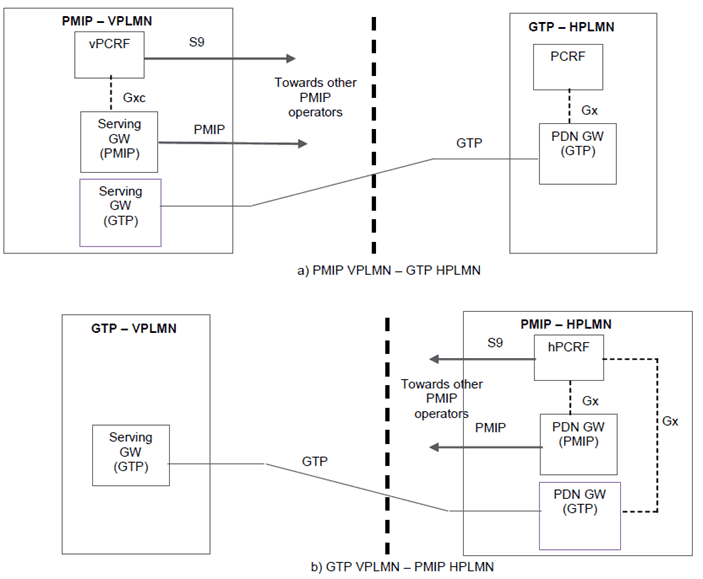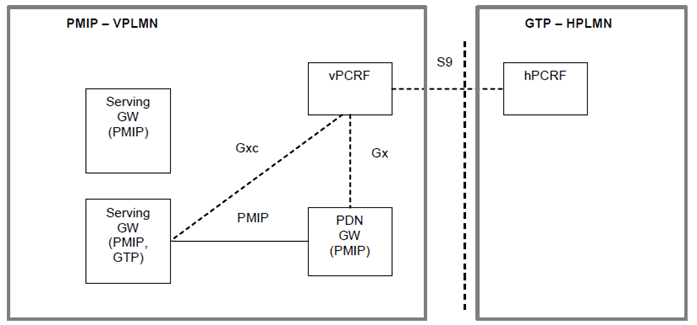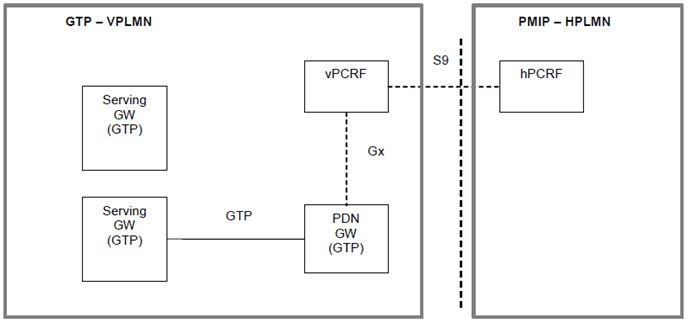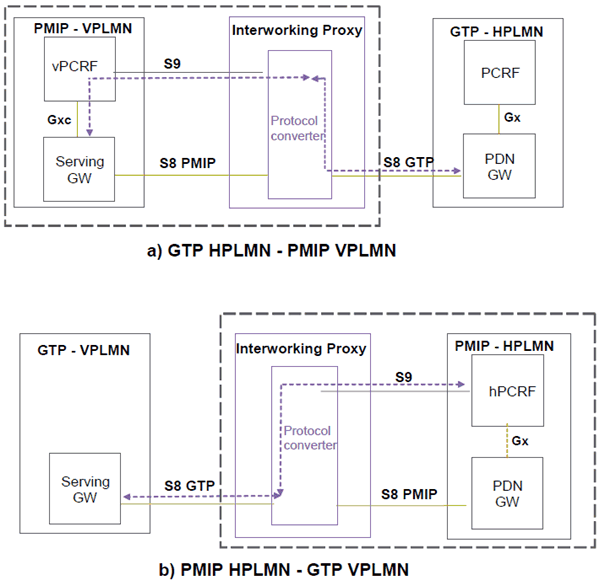Content for TS 23.402 Word version: 18.3.0
0…
4…
4.2…
4.2.2
4.2.3
4.3…
4.4…
4.5…
4.5.7…
4.6…
4.7…
4.7.2…
4.8…
4.8.2a…
4.9…
5…
5.2…
5.4…
5.5
5.6…
5.7…
5.8…
6…
6.2…
6.3
6.4…
6.4.3…
6.5…
6.6…
6.7…
6.8…
6.10…
6.13…
6.15…
7…
7.2…
7.3
7.4…
7.5…
7.6…
7.8…
7.10…
8…
8.2.1.2
8.2.1.3…
8.2.2
8.2.3…
8.2.6…
8.3…
8.4…
8.5…
9…
9.3…
9.4…
10…
13…
16…
16.1.2…
16.1.6…
16.2…
16.2.1a…
16.3…
16.4…
16.7…
16.8…
16.10…
17…
A…
C…
E…
A GTP - PMIP Roaming
A.1 Direct Peering Scenario
A.2 Proxy-based interworking
B Guidance for Contributors to this Specification
...
...
A GTP - PMIP Roaming p. 298
The scenarios below identify and describe various deployment scenarios for interworking between EPC networks based on GTP and EPC networks based on PMIP. The scenario described here are the direct peering scenario and the proxy-based interworking.
A.1 Direct Peering Scenario p. 298
The "direct peering" scenario consists in having one of the two roaming partners provide support for both variants of roaming flavour (e.g. a PMIP operator would support GTP-based roaming interface towards a GTP-only roaming partner, or vice versa) in order to make roaming possible.
The support for such roaming flavour can be provided either on the same GW node or on different GW nodes. Upon establishment of connectivity for a specific roaming UE, the Visited network chooses a GTP-based or a PMIP-based S8 interface (on the same GW node or on different GW nodes, note that for a single user only a single Serving-GW is allocated when connecting to EPC), depending on the preferences of the roaming partner that owns the subscriber.

Figure A.1-1: Direct peering examples: a) PMIP-based VPLMN to GTP-based HPLMN; b) GTP-based VPLMN to PMIP-based HPLMN
(⇒ copy of original 3GPP image)
(⇒ copy of original 3GPP image)
Depicted in Figure A.1-1 (a) is an example of "direct peering" interworking between a GTP-based HPLMN and a PMIP-based VPLMN. When roamers whose subscription is owned by the GTP-based operator attach to the EPS network of the PMIP-based operator, they are assigned a GTP-capable GW acting in the role of S-GW. The S-GW selection is carried out by MME or SGSN based on the subscriber's HPLMN. In case of the Serving-GW supporting both GTP and PMIP, the MME/SGSN should indicate the Serving-GW which protocol should be used over S5/S8 interface.
Depicted in Figure A.1-1 (b) is an example of "direct peering" interworking between a PMIP-based HPLMN and a GTP-based VPLMN. When roamers whose subscription is owned by the PMIP-based operator attach to the EPS network of the GTP-based operator, they are assigned a GTP-capable S-GW. The information provided by the PMIP-based HPLMN for the P-GW selection function must take into account that the Visited network is GTP-only, in order to return either the IP address (or an APN that can be resolved to an IP address according to the PDN-GW resolution mechanism) that points to a GTP-capable PDN-GW.
Figure A.1-2 depicts the scenario in which a UE from a GTP-based network roams in a PMIP-based network, local breakout is used, and home-routed bearers are also possible. As with the home-routed case, the MME or SGSN in the PMIP-based VPLMN selects a GTP-capable Serving-GW, but it selects a PMIP capable PDN-GW. As a result, the S-GW in this example supports both GTP and PMIP based S5/S8. This allows the local breakout bearer and any associated home-routed bearer for the user (e.g. the default bearer) to be served by the same Serving-GW. Support of S9 may not be required in all local breakout scenarios.

Figure A.1-2: Direct peering example: Local Breakout, UE from GTP HPLMN Roaming in PMIP VPLMN
(⇒ copy of original 3GPP image)
(⇒ copy of original 3GPP image)
Figure A.1-3 depicts the scenario in which a UE from a PMIP-based network roams into a GTP-based network and local breakout is used. As with the home-routed case, the MME/SGSN in the GTP-based VPLMN selects a GTP-capable Serving-GW and the PDN-GW selection function selects a GTP-capable PDN-GW. This allows the local breakout bearer and any associated home-routed bearer for the user (e.g., the default bearer) to be served by the same Serving-GW. Support of S9 may not be required in all local breakout scenarios.

Figure A.1-3: Direct peering example: Local Breakout, UE from PMIP HPLMN Roaming in GTP VPLMN
(⇒ copy of original 3GPP image)
(⇒ copy of original 3GPP image)
A.2 Proxy-based interworking p. 300
In this scenario an Interworking Proxy (IWP) sits between the GTP-based PLMN and the PMIP-based PLMN to perform protocol conversion between the GTP protocol on one side and the PMIP and Diameter protocols on the other side.

Figure A.2-1: Roaming Via Interworking Proxy: a) GTP-based HPLMN to PMIP-based VPLMN; b) PMIP-based HPLMN to GTP-based VPLMN
(⇒ copy of original 3GPP image)
(⇒ copy of original 3GPP image)
The IWP is inserted transparently in the signalling and bearer path i.e. no changes to the GTP, PMIP and Diameter protocols are required.
B Guidance for Contributors to this Specification p. 302
The following guidance is provided for drafting figures for this specification that share some common procedures with TS 23.401.
Representation of PMIP or GTP variants of S5/S8:
- Flows to TS 23.401 will contain the complete procedures for GTP-based S5/S8.
- In TS 23.401, clause(s) of a flow that is different for PMIP version of S5/S8 interface are shown surrounded by shaded box indexed by capital letter in ascending order, e.g. "A", "B", "C", etc.
- At the bottom of the flow, the following text should be included, e.g.
- In this specification, each step for the relevant clause, belonging to say annex A, of the flow should be indicated by "A.1, A.2, …". In this specification common clauses of the flow captured in TS 23.401, should be indicated by shaded boxes with text, e.g. "Procedures in TS 23.401, Figure x.y.z-k, before A", "Procedures in TS 23.401, Figure x.y.z-k, between A and B", etc.
- For each case supported, indicate the presence of the optional network entities that may be included in the procedure step. These optional entities appear between the source and destination of the procedure interaction arc as a gray circle. For example, a vPCRF may stand between the Serving-GW and the hPCRF.
- In text following a procedure diagram, list the different cases supported by the Figure.
- For each case that is supported, indicated what the role of the optional network entity is, when it occurs in the interaction. For example, "In the roaming case, the vPCRF forwards messages between the Serving-GW and the PDN-GW".
- In text following a procedure diagram, list the specific impacts arising from multiple PDN connectivity. This will chiefly include a description of which interactions in the Figure may be repeated N times for each PDN connected to.
- PMIP-based S2b call flows will contain the complete procedures;
- Clause(s) of a PMIP-based S2b flow that is different for the GTP variant of the S2b interface are shown surrounded by shaded box indexed by capital letter in ascending order, e.g. "A", "B", "C", etc.
- At the bottom of the flow, the following text should be included, e.g.
- In GTP based S2b call flows, each step for the relevant clause, belonging to say annex A, of the flow should be indicated by "A.1, A.2, …" . Common clauses of the flow should be indicated by shaded boxes with text referring to the PMIP based S2b call flow, e.g. "Procedures in Figure x.y.z-k, before A", "Procedures in Figure x.y.z-k, between A and B", etc.